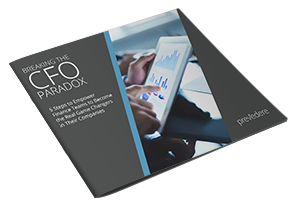Last Updated: January 29, 2021
It’s no secret that many companies today are off on their demand forecasting methods. Read any recent news article on the topic, and you’ll likely find that most Fortune 500 executives who missed the mark blamed external factors, such as the stronger dollar, a drop in oil prices or changes in the housing market.
While companies may understand that a correlation exists between the strength of the dollar and their quarterly sales reports, the truth is that when they initially create sales projections, there is usually no proven internal process to determine precisely which factors may or may not impact upcoming performance.
Call it what you will – a gut feeling, historically based assumptions – but typical business demand forecasting methods processes are mainly based on guesswork. In fact, only 12% of executives feel highly confident in their forecasting processes, according to a survey we recently conducted.
Prevedere commissioned a survey conducted by Gatepoint Research of 100 executives, directors and managers in businesses with revenue greater than $250 million (65% work in Fortune 1000 companies with revenues over $1.5 billion) about their business forecasting processes. We found that most businesses are stuck playing a perpetual guessing game when it comes to demand forecasting. Typically, the forecasting process simply included examining last year’s or last quarter’s data to “guess” the next quarterly forecast.
Here are three demand forecasting methods to avoid.
1 – Inaccurate Forecasts
Executives know their forecasts are inaccurate but don’t realize that the problem lies in the process. Astonishingly, nearly half of the survey respondents cited they had missed their business targets due to inadequate or inaccurate forecasting, yet 62% thought their forecasting capabilities were better than average. Time and again businesses are reporting that their forecasts are off, but most executives blame external factors – not the forecasting process itself.
2 – Difficulty Pinpointing Key Drivers
Executives have difficulty pinpointing key business drivers. They realize that external factors significantly impact business performance. In fact, two-thirds of respondents admitted that external factors have adversely affected the accuracy of their business forecasts. However, despite 77% of respondents depending upon analysts and data scientists, these same respondents still struggle to understand critical indicators that impact their businesses. 44% admitted that they either could not or were unsure of how to determine the key drivers of their companies’ performance.
3 – Accurate & Timely Forecasting
Accurate, timely forecasting is a significant challenge for businesses. Timing is critical when it comes to predicting business performance. Simply reporting the past doesn’t help executives plan for the future. Nearly 60% of executives in our survey reported that accurate, timely forecasts are a significant challenge, suggesting that they don’t have the systems and processes in place to gather and leverage real-time intelligence in their forecasting processes.
What’s next in demand forecasting methods and processes?
Without question, businesses are struggling to create the right processes that will help them build more meaningful forecasts. While most companies know their current forecasts continue to be inaccurate, they don’t realize that their methods need work, and if they do, they simply don’t know where to begin.
 While it’s helpful to know that the strength of the U.S. dollar impacts your sales, knowing exactly how and when it will affect all levels of your business, production, logistics, demand and even labor provides executives a 360° outlook that drives better decisions.
While it’s helpful to know that the strength of the U.S. dollar impacts your sales, knowing exactly how and when it will affect all levels of your business, production, logistics, demand and even labor provides executives a 360° outlook that drives better decisions.
A more granular level of demand forecasting method and process will have the greatest business impact to ensure that the right products are in the right place at the right time at the right price and with staffing to support these needs. You can read an additional CFO resource that explores how demand forecasting is executed.
Th Institute of Business Forecasting and Planning’s (IBF) Benchmarking Forecasting Errors report details the difficulties businesses have in improving demand forecasting accuracy at the granular level. The IBF’s study had an average error rate of 10.4% and 15%, those at the SKU level were between a staggering 27% to 37.7%.
If you have experienced any of these common demand forecasting questions, Prevedere, executives can take the guesswork out of forecasting and gain the kind of actionable intelligence that produces results. In today’s volatile economy, historic forecast accuracy benchmarks are simply unacceptable. Contact us to learn how we’re changing the model.
***
 Download complimentary ‘CFO Playbook Report,’ to explore demand forecasting accuracy tools >>
Download complimentary ‘CFO Playbook Report,’ to explore demand forecasting accuracy tools >>